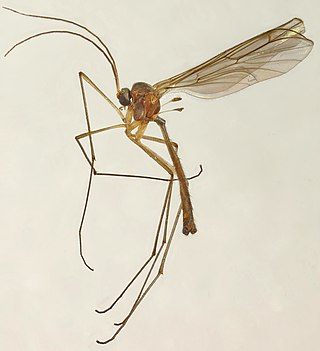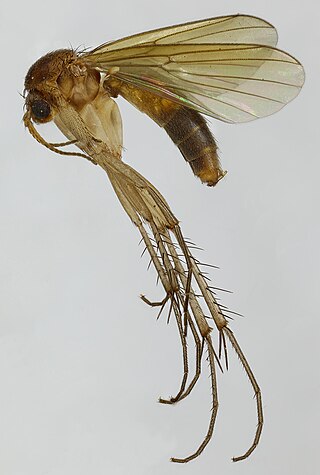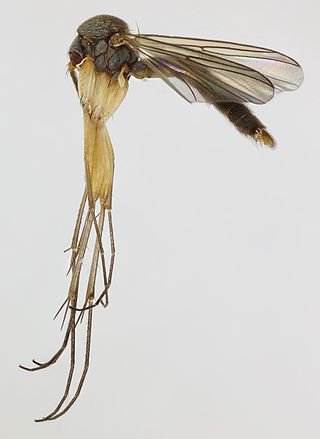
The Nematocera are a suborder of elongated flies with thin, segmented antennae and mostly aquatic larvae. This group is paraphyletic and contains all flies but species from suborder Brachycera, which includes more commonly known species such as the housefly or the common fruit fly. The equivalent clade to Nematocera is the whole Diptera, with Brachycera as a subclade. Families in Nematocera include mosquitoes, crane flies, gnats, black flies, and multiple families commonly known as midges. The Nematocera typically have fairly long, fine, finely-jointed antennae. In many species, such as most mosquitoes, the female antennae are more or less threadlike, but the males have spectacularly plumose antennae.

Mycetophilidae is a family of small flies, forming the bulk of those species known as fungus gnats. About 3000 described species are placed in 150 genera, but the true number of species is undoubtedly much higher. They are generally found in the damp habitats favoured by their host fungi and sometimes form dense swarms.

The Sciaridae are a family of flies, commonly known as dark-winged fungus gnats. Commonly found in moist environments, they are known to be a pest of mushroom farms and are commonly found in household plant pots. This is one of the least studied of the large Diptera families, probably due to the small size of these insects and the similarity among species.

Keroplatidae is a family of small flies known as fungus gnats. About 950 species are described, but the true number of species is undoubtedly much higher. The long-beaked fungus gnats, formerly placed in a separate family Lygistorrhinidae, have been placed into Keroplatidae as subfamily Lygistorrhininae. They are generally forest dwellers found in the damp habitats favoured by their host fungi. They can also often be found in caves. Larvae both feed on fungi and are predatory - they can spin webs by secreting acid fluids, which they use to kill smaller invertebrates and capture spores. Some of the predatory larvae cannibalize pupa of their own species. The family notably include the genus Arachnocampa; the larvae of which are known as "glowworms" in Australia and New Zealand.

Sciaroidea is a superfamily in the infraorder Bibionomorpha. There are about 16 families and more than 15,000 described species in Sciaroidea. Most of its constituent families are various gnats.

Bolitophila is the sole living genus in the Bolitophilidae, a family of Diptera in the superfamily Sciaroidea, with around 40 Palaearctic and about 20 Nearctic species, and three species from the Oriental region (Taiwan). They are small (6–9 mm).

Diadocidia ferruginosa is a Palearctic species of fungus gnat in the family Mycetophilidae. They live as larvae in long dry silken tubes under bark or in rotten wood and probably feed on fungal mycelia or spores. Also associated with Peniophora.

Mycetophila fungorum is a Palearctic species of 'fungus gnats' in the family Mycetophilidae. Mycetophila fungorum is found in forest or wooded areas where the larvae develop in Agaricales and also obtained with emergence traps over dead wood, soil and ground flora.

Boletina gripha is a Palearctic species of 'fungus gnats' in the family Mycetophilidae. It is found in a wide variety of habitats from wooded streams to wetlands and open moorland. Reared from brown rot of spruce stump, spruce log bearing loose bark and decaying wood of pine. Larvae have been on the surface of decaying wood covered with Resinicium bicolor, from soil in pine forest and from fruiting bodies of Suillus bovinus.

Brachypeza bisignata is a Palearctic species of 'fungus gnat' in the family Mycetophilidae. Reared from puffballs (Lycoperdales).

Boletina trivittata is a Palearctic species of fungus gnat in the family Mycetophilidae. Members of this genus live in a wide range of habitats, from wooded streams to wetlands to open moors. Adults have been insect trapped on a variety of substrates, including rotting wood and soil litter.

Brevicornu foliatum is a Palearctic species of 'fungus gnat' in the family Mycetophilidae. Members of this genus are found in a wider variety of habitats from wooded streams to wetlands and open moorland. Larvae develop in dead wood and in soil litter, feeding probably on microfungi.

Mycetophila is a genus of fungus gnats in the family Mycetophilidae. There are at least 740 described species in Mycetophila.

Exechia is a genus of fungus gnats in the family Mycetophilidae. There are more than 180 described species in Exechia.
Pnyxia is a genus of dark-winged fungus gnats, insects in the family Sciaridae. There are at least four described species in Pnyxia.
Aglaomyia is a genus of fungus gnats in the family Mycetophilidae. There are at least two described species in Aglaomyia.

Rondaniella is a genus of fungus gnats in the family Mycetophilidae. There are about nine described species in Rondaniella.
Ectrepesthoneura is a genus of fungus gnats in the family Mycetophilidae. There are more than 20 described species in Ectrepesthoneura.

Gnoriste is a genus of fungus gnats in the family Mycetophilidae. There are about 13 described species in Gnoriste.

Allodiopsis is a genus of fungus gnats belonging to the family Mycetophilidae.




















